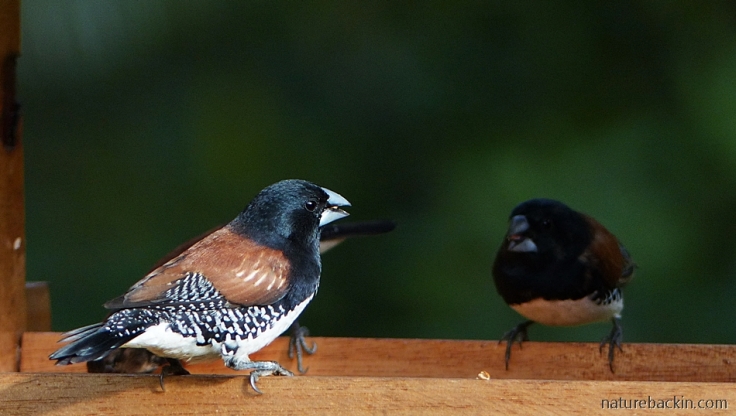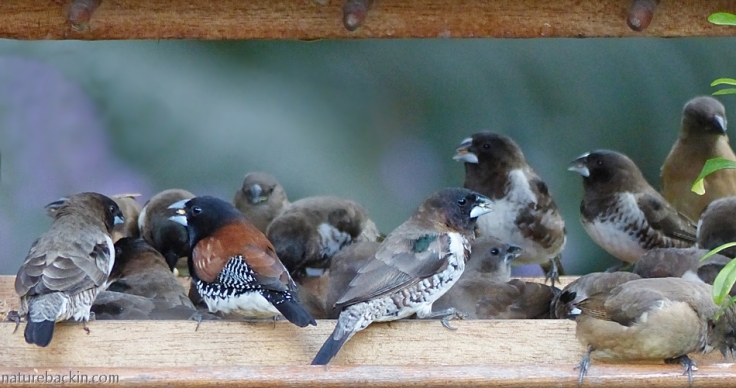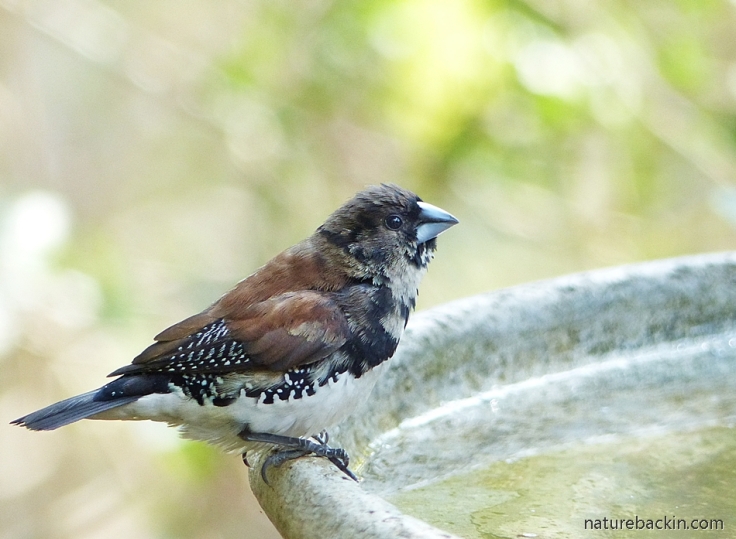Small flocks of mannikins are frequent garden visitors, arriving in a sudden flurry often accompanied by high-pitched chirping. These are very small birds weighing only 10 g (less than half an ounce).
In the breeding season they live in pairs or in small family groups, and when not breeding and throughout the winter they associate in small tightly-knit flocks. In our garden, groups of visiting mannikins are often mixed groups of Red-backed and Bronze Mannikins.

Adult Red-backed Mannikins at our winter bird feeder

A Bronze Mannikin, so named because of the bronze-coloured iridescent shoulder patch. Although Roberts (Multimedia edition) says that Bronze Mannikins are tame and easy to approach, I have found them to be wary and flighty, and so difficult to photograph. If one bird in a group takes fright, the entire flock is alerted and takes off in a seemingly single reflex

At our bird feeder Red-backed Mannikins and Bronze Mannikins rub shoulders. The buff-coloured birds are juveniles
Mannikins form monogamous breeding pairs, with the male collecting fresh grass stems as nesting material and the female building the nest that is in an untidy ball. Pairs have complex courting behaviours that including bobbing and bowing, bill clicking, tongue wagging, and ritualised bill wiping and preening. Both parents participate in raising the young.
Nests are often reused for further broods and may also be used for roosting. Outside of the breeding season, mannikins roost communally, often clumping or huddling together for warmth. There is evidence that dominant birds in the group hierarchy get the warmest places at the centre of the huddle.
Mannikins also build specialised roosting nests that are used communally. These roosting nests are tubular and open at both ends. They are built by groups of birds and may be used over a period of several months.

A Red-backed Mannikin, showing off its russet colours for which it is named

An immature Red-backed Mannikin in the process of attaining its full adult plumage

A juvenile Red-backed Mannikin, drab in appearance compared to the adults

Mannikins usually forage in groups, often on the ground or from seed heads of grasses. Mannikins are predominantly seed eaters, and food includes grass seeds, supplemented by some fruits, leaves and petals, certain insects and nectar

Red-backed Mannikins at the birdbath. They are dependent on the presence of water

The mannikins also venture to use the garden pond for both drinking and bathing

And to end, a Bronze Mannikin at the garden pond. This photo has been edited using Photoscape
Sources: Hugh Chittenden, Greg Davies, Ingrid Weiersbye. 2016. Roberts Bird Guide: Illustrating nearly 1,000 Species in Southern Africa (2nd edition). Cape Town: Jacana; Roberts VII Multimedia PC Edition. 1997-2016 Southern African Birding. For details go to http://www.sabirding.co.za/roberts7/portal.html
Posted by Carol









December 10, 2020 at 6:29 am
The pictures are beautiful and the info was lovely to read as we currently have a pair building at our patio door. What a mess but a treat to watch and we have named these two Gladys and Bob the builder. They have been at this for a full week already and wondered when they may settle.
LikeLiked by 1 person
December 10, 2020 at 8:39 pm
Oh how lovely to have Gladys and Bob building so trustingly. I do hope they go on to raise a brood.
LikeLike
September 16, 2018 at 9:42 pm
Very nice photos and interesting information. In Hawaii we have chestnut munias (also known as chestnut mannikins) and nutmeg mannikins (also known as scaly-breasted munias). I most often see the nutmeg mannikins hanging on to the swaying ends of cane grass when it’s gone to seed.
LikeLiked by 1 person
September 20, 2018 at 8:19 pm
Interesting to know there are also mannikins/munias in Hawaii.
LikeLiked by 1 person
September 14, 2018 at 7:04 pm
LOVELY photographs!
LikeLiked by 1 person
September 15, 2018 at 5:33 am
Thanks so much Anne.
LikeLike
September 14, 2018 at 2:42 am
They’re the cutest little birds and you have lovely images of them, Carol! We are also lucky to have a small flock of bronze mannikins frequenting our small garden here in Pretoria.
LikeLiked by 1 person
September 14, 2018 at 6:21 am
Thanks so much. Glad to know they are also present in Pretoria gardens.
LikeLiked by 1 person
September 14, 2018 at 2:05 am
Interesting to learn about these beautiful little birds.
LikeLiked by 1 person
September 14, 2018 at 6:20 am
Thanks Belinda. I also found them to be so interesting. I had not been aware of their roosting nests until reading for this post.
LikeLiked by 1 person
September 13, 2018 at 10:03 pm
Such pretty little birds. They remind me of tri-colored munias (from Asia), a pair of which I kept as pets when I was a teenager. Nowadays, I’d not have caged birds, but things were different back then.
LikeLiked by 1 person
September 14, 2018 at 6:18 am
I think the names munia and mannikan are pretty much interchangeable though munia is more often used for the Asian species. I agree with what you say about caged birds. Best not to look too pretty or sing too prettily if you are a bird needing to avoid being caught up in the caged-bird trade.
LikeLike
September 14, 2018 at 3:01 pm
It is a sad business for sure. Some face extinction in the wild, which is a horrible thing.
LikeLiked by 1 person
September 15, 2018 at 5:31 am
Very sad indeed.
LikeLike
September 13, 2018 at 9:44 pm
Smashing photos!
I don’t recall seeing the Red-backed Mannikin, but we have flocks of the Bronze.
LikeLiked by 1 person
September 14, 2018 at 6:12 am
Thanks Ark. They are lovely visitors.
LikeLike
September 13, 2018 at 9:29 pm
The red backed mannikin is very smart in his Sunday best!
LikeLiked by 1 person
September 14, 2018 at 6:08 am
Yes, they are definitely well turned out!
LikeLike
September 13, 2018 at 8:52 pm
These are beautiful little birds, Carol. I love the russet coloring. And the black
barring reminds me a bit of Downey Woodpeckers.
LikeLiked by 1 person
September 14, 2018 at 6:08 am
I have just taken a look at the equally beautifully barred Downey Woodpecker ☺
LikeLiked by 1 person